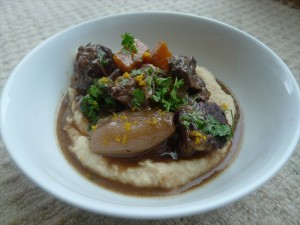 The first time we traipsed to a supermarket in Britain, The Hungry One was agog. There I was, busy puzzling over ‘Fairy liquid’ when he appeared clutching a champagne sized bottle of something in his hands.
The first time we traipsed to a supermarket in Britain, The Hungry One was agog. There I was, busy puzzling over ‘Fairy liquid’ when he appeared clutching a champagne sized bottle of something in his hands.
‘Three pounds! Three pounds for Leffe!’ he said shaking his head in disbelief.
It was at that point I knew it would be hard to get him back to Australia (where he used to pay much more than that).
Belgian ales are his weakness; his Achilles heel. They were panaceas for crummy weeks. They were what we marked birthdays with. And they were what urged him onto the finish line of his marathon, when at kilometer 39 I started bleating that I’d deposited a bottle of Chimay in the minibar of the hotel.
These days we’ve found a greater playground than supermarkets for ales. Right in the centre of Borough Markets, from Wednesday to Saturday you’ll find Uto Beer. It’s a cornucopia for beer nuts; stocking more than 2000 boutique varieties from all over the world. If I’m not careful I can loose him in there for an hour or more.
Most Fridays I’ll make use of Uto. After my trip around the markets I’ll wander in, let them know what I’m cooking for tea and ask them to recommend one of two things to compliment it. From black pudding with raspberries and radishes, to mussels with chorizo and fennel, they’ve always been able to muster an interesting match.
Last Friday, it wasn’t that tricky.
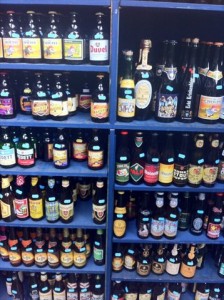 The next morning The Hungry One was leaving me off once more- this time to Romania with his Dad.
The next morning The Hungry One was leaving me off once more- this time to Romania with his Dad.
It was cold and dreary outside the window. I wanted something warm and forgiving that the menfolk would enjoy. Beef Carbonnade it was. Flemish in origin and as 70’s as prawn cocktail and black forrest cake, it’s hunks of beef, slow cooked in beer. Over time whole baby onions and chunks of carrots soften. The beer thickens into a sticky gravy and the beef relaxes like a man who’s just walked in the door, toed off his boots and shirked out of his jacket.
If I was in Australia and making this I’d employ a local pale ale. But because I could (three pounds at Tesco!) I used Leffe. I added orange zest and sprinkle of chervil to the braise to play up the citrus and aniseed notes in the beer. All that it needed was three hours in the oven and a little bit of mustard for punch.
Later that night we consumed it over white bean puree with a few more Belgium ales while we looked out over London and he contemplated his fourth trip away in as many weeks.
This morning he returned from Bucharest and Brasov with one question top of mind.
‘Is there any of the stew left?’.
Here’s another great things about this braise. It makes plenty and stretches easily. And beyond that- if possible, the flavours get better day by day.
He’s just eaten the leftovers for lunch and assured me he’s not going anywhere again for a while. It might be because he missed me. It might be because I promised another stew this Friday. Or it might have something to do with the Chimay that’s sitting in the door of the fridge.
Beef Carbonnade (Beef slow cooked in beer)
Equipment
1 Dutch oven/flame proof-oven friendly casserole dish with a lid. 1 zester.
Shopping/foraging
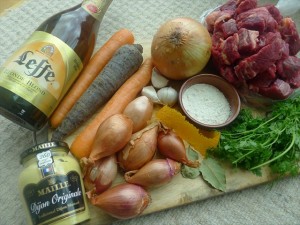 1 kilogram of chuck steak, or beef shin with a good amount of sinew marbled through, cut into 1 inch cubes
1 kilogram of chuck steak, or beef shin with a good amount of sinew marbled through, cut into 1 inch cubes
1 teaspoon of salt
1 teaspoon of ground black pepper
2 tablespoons of olive oil
3 medium carrots, peeled and cut into 1 cm half rounds (I used two orange carrots and one purple, for novelty)
6 eschallots/small pickling onions, peeled and kept whole
1 medium brown onion cut into small dice
3 garlic cloves, finely diced
1 tablespoon of plain flour (or ground chia or chickpea flour)
500 ml of beer (Leffe Blonde, though most aromatic beers would work well)
2 bay leaves
1 strip of orange zest, the circumference of a medium orange, plus a little grated orange zest to serve.
3 teaspoons of Dijon mustard (plus extra, or hot English mustard to serve)
1 small bunch of chervil, or flat leaf parsley, roughly chopped
Plus noodles, mashed potato, or white bean puree.
Here’s how we roll
1. Preheat the oven to 150 C/300 F.
2. Peel and dice all of your vegetables.
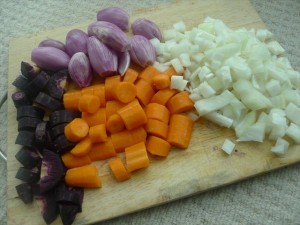 3. Add the olive oil to the bottom of the Dutch oven. Season the beef chunks with salt and pepper. Brown the meat in batches. Make sure you get a good brown crust on the meat- this is the basis of much of the flavour in the braise. If you crowd the pan the meat will limply stew rather than crisply sear- you don’t want this. When the meat is brown on all edges remove and place it on a plate to the side. Repeat with the remaining meat. If the pan is too dry, add a little more olive oil.
3. Add the olive oil to the bottom of the Dutch oven. Season the beef chunks with salt and pepper. Brown the meat in batches. Make sure you get a good brown crust on the meat- this is the basis of much of the flavour in the braise. If you crowd the pan the meat will limply stew rather than crisply sear- you don’t want this. When the meat is brown on all edges remove and place it on a plate to the side. Repeat with the remaining meat. If the pan is too dry, add a little more olive oil.
4. Add another tablespoon of olive oil and add all of the diced vegetables, bay leaves and the orange zest into the same pan- it’s ok if there is some residue from the meat clinging onto the bottom. Saute the vegetables for 5 -10 minutes over a medium heat to soften some them a little and add a hit of colour.
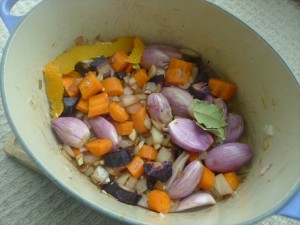
5. Sprinkle the flour over the top of the vegetables and stir to incorporate (this will help to thicken the sauce). Continue stirring for a minute to cook out some of the flour.
6. Return the meat and any juices that have leached out onto the plate into the pan. Stir to combine. Then pour over the beer and add three teaspoons of Dijon mustard into the pot. Ensure that there is enough beer to just come to the top of the meat. If your pot is a different size add some more so that the majority of the stew is covered, but some bits pop out the top like floating islands.
 7. Turn the heat up to high and allow the beer to come to a boil. As soon as it does take the pan off the heat, clamp the lid on and place in the oven for two hours.
7. Turn the heat up to high and allow the beer to come to a boil. As soon as it does take the pan off the heat, clamp the lid on and place in the oven for two hours.
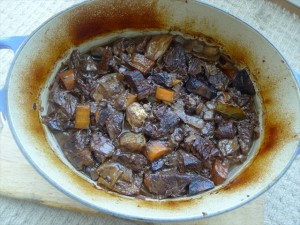 8 . After two hours take off the lid and bake for another hour. This will help the sauce reduce.
8 . After two hours take off the lid and bake for another hour. This will help the sauce reduce.
9. When done the meat should flake apart, the carrots and onions should be pliable and soft and the sauce sticky and rich. If you’re not quite at that point, return the stew to the oven (nb, you could also cook this on low in a slow cooker all day, though the sauce will be thinner).
9. Top with diced chervil and a dusting of grated orange zest. If not chervil, diced parsley is also fine.
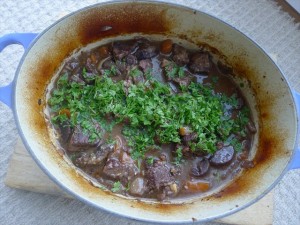 10. Serve with mashed potatoes, or white bean puree.
10. Serve with mashed potatoes, or white bean puree.


Love this post -might have something to do with the fact that the husband and I enjoyed mussels and frites at a Belgian beer cafe this weekend.
What a beautiful dish! I love the flavors, and the fact that it’s cooked in beer!
I love Leffe – though being something of a lightweight, I’m normally tipsy after one bottle! Haven’t eaten a carbonnade in years – for more 70s recipe inspiration, read Simon Hopkinson’s brilliant The Prawn Cocktail Years, it’s one of my favourite cookbooks.
I suppose we are quite spoiled with beer, even in supermarkets, here in Europe. So I will be making this quite soon I believe.
I love Carbonnade! And I miss how relatively cheap things were in the UK compared to expensive old New Zealand…